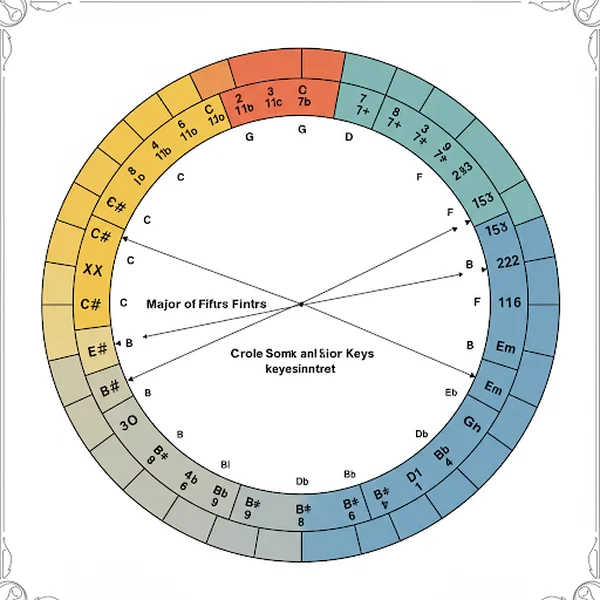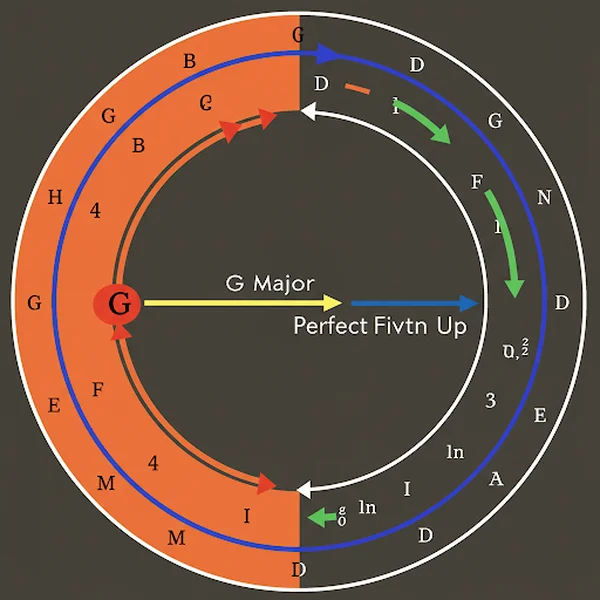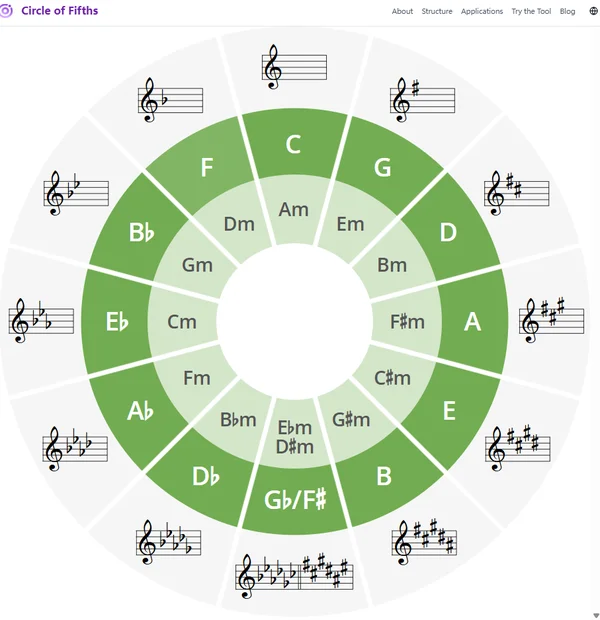Transpose Music Easily: Use the Circle of Fifths
Ever wondered How to use the circle of fifths to change keys? Music transposition might seem daunting, but it's an essential skill for musicians, arrangers, and songwriters. Whether you need to adjust a song for a vocalist's range, adapt a piece for different instruments, or simply explore new creative avenues, understanding how to transpose music opens up a world of possibilities. The good news is that the Circle of Fifths is a powerful visual aid that can make this process remarkably straightforward. Ready to master this skill? Explore our interactive tool and see how easy it can be!
What is Music Transposition and Why Is It Crucial for Musicians?
What is music transposition? Simply put, music transposition is the process of moving a collection of notes (a melody, a chord progression, or an entire piece of music) up or down in pitch by a constant interval. This means every note is shifted by the same amount, preserving the melodic contours and harmonic relationships within the piece, just in a new key.
Why is this so important?
- Vocal Ranges: Singers have different comfortable vocal ranges. Transposition allows a song to be adapted to fit a specific singer's voice perfectly.
- Instrumental Needs: Many instruments are "transposing instruments" (like trumpets in Bb or saxophones in Eb). This means the note they read is different from the actual concert pitch produced. Arrangers must transpose parts for these instruments.
- Arrangement and Composition: Sometimes, a piece sounds better or is easier to play in a different key. Composers and arrangers often use transposition as a creative tool.
- Modulation: Within a single piece of music, composers might change keys (modulate) for musical effect. Understanding transposition is key to understanding modulation.
Learning how to transpose music effectively is a fundamental part of music theory and practice.
The Circle of Fifths: Your Go-To for Easy Music Transposition
If you're looking for an intuitive way to change keys music, the Circle of Fifths is your best friend. This ingenious diagram visually represents the relationships between the twelve chromatic pitches. Its circular arrangement makes it incredibly easy to see how keys relate to one another, how many sharps or flats each key has (their key signatures), and, crucially for us, how to move between them. For easy music transposition, the Circle of Fifths provides a clear roadmap. You can check out the Circle of Fifths here to visualize these relationships.

Core Principles: Understanding How to Transpose Music
Before diving into using the Circle of Fifths directly, let's cover some basic principles. How do you change the key in circle of fifths? It starts with understanding intervals and key relationships.
The Basics of Changing Keys: Intervals and Key Relationships
Transposition is all about shifting notes by a specific musical interval. An interval is simply the distance between two notes. For example, moving from C to G is an interval of a perfect fifth. When you transpose, you apply the same interval to every note and chord.
Identifying Your Starting Point: The Original Key
The first step is always to determine the original key of the music. This often involves looking at the key signature and the final chord of the piece. Our interactive Circle of Fifths can help you quickly identify key signatures.
Setting Your Destination: The Target Key
Next, decide on your target key – the key you want to transpose the music into. This choice might be dictated by a singer's range, the instrument you're writing for, or a desired musical effect.
How to Transpose Music Using the Circle of Fifths: A Step-by-Step Guide
Now, let's get practical. How do you transpose a circle of fifths for melodies and chords? Here’s a step-by-step approach using this powerful tool:
Step 1: Locate the Original Key on the Circle of Fifths
Find the current key of your piece on the Circle of Fifths chart. For instance, if your song is in G Major, locate G on the circle.
Step 2: Find Your Target Key and Determine the Interval
Decide which key you want to move to. Let's say you want to transpose from G Major to D Major.
- On the Circle of Fifths, moving clockwise represents moving up by a perfect fifth (or down by a perfect fourth).
- Moving counter-clockwise represents moving down by a perfect fifth (or up by a perfect fourth).
To go from G Major to D Major, you move one step clockwise. This interval is a perfect fifth up (or a perfect fourth down, depending on how you count). The distance and direction on the Circle tell you the transposition interval.

Step 3: Transpose Each Note of the Melody
Once you know the interval, apply it to every note in your melody. If you're moving from G Major to D Major (up a perfect fifth), every G becomes a D, every A becomes an E, every B becomes an F#, and so on. You're essentially shifting the entire melodic line. This is where a good grasp of musical intervals comes in handy.
Step 4: Transpose Chords (Keeping Their Quality)
Chords are transposed by moving their root notes by the same interval, while maintaining the chord's quality (major, minor, dominant 7th, etc.).
- If your original G Major progression was G - C - D - G.
- Transposing to D Major (up a perfect fifth):
- G Major becomes D Major.
- C Major becomes G Major.
- D Major becomes A Major.
- The final G Major becomes D Major. The new progression is D - G - A - D. The Circle of Fifths tool can visually show you these new chord roots as you select different keys, making it an excellent songwriting aid.
Using Our Interactive Tool for Fast Transposition
Is there a tool for music transposition? Yes! Our interactive circle of fifths tool is designed to make transposition incredibly efficient.
Effortless Transposition with Our Interactive Circle of Fifths Tool
While the manual steps are important to understand, our music transposition tool streamlines the process. When you select a key on our interactive circle, it can instantly show you related chords and scales, making it easier to see how your transposed piece will look and sound. You can visualize the new key signatures and corresponding chords with a simple click when you visit our site.

Master Music Transposition with Confidence
Recap: Transpose Music Easily with the Circle of Fifths
Transposing music doesn't have to be a complex chore. By understanding the core principles and utilizing the visual power of the Circle of Fifths, you can confidently change keys music for any melody or chord progression. This skill is invaluable for any musician, opening doors to better arrangements, accommodating performers, and enhancing your overall understanding of music theory basics.
Your Turn: Practice Transposing with Our Tool!
The best way to master transposition is to practice. We encourage you to visit our website and use our interactive circle of fifths tool to experiment. Pick a simple melody or chord progression and try transposing it to a few different keys.
Transposing with the Circle of Fifths
Here are answers to some common questions about using the Circle of Fifths for transposition:
How do you quickly change a song's key using the Circle of Fifths?
Locate your original key on the Circle. Determine your target key. Count the "steps" (perfect fifths) clockwise or counter-clockwise to find the interval. Apply this interval to all notes and chord roots. Our interactive tool can help you visualize this instantly by simply selecting the new key.
Can I use the Circle of Fifths to transpose from major to minor keys?
While the Circle of Fifths primarily shows relationships between major keys (and their relative minors), transposition itself is about shifting pitch. You can transpose a minor piece to another minor key using the same interval principles. For example, A minor to E minor is up a perfect fifth. The Circle helps identify the root movement and new key signature.
What's the best way to practice transposition with an interactive tool?
Start with simple melodies. Use an interactive circle of fifths tool like the one on our site to select your original key, then click on different target keys. Play the transposed melody on your instrument. Gradually move to transposing chord progressions. The visual feedback is invaluable.
How can the Circle of Fifths help with transposition?
The Circle of Fifths visually maps out all twelve keys and their relationships. It clearly shows the number of sharps or flats in each key and the distance (in perfect fifths) between keys. This makes it easy to determine the interval needed for transposition and to find the new key signatures and corresponding chords.
Does the Circle of Fifths help when transposing complex jazz chords?
Absolutely. While jazz harmony can be complex, the root movements of chords still follow the principles visualized by the Circle of Fifths. Transposing a ii-V-I progression, for example, becomes much clearer when you can see the root relationships on the Circle. You would still need to maintain the chord qualities (e.g., m7, dom7, maj7) after transposing the roots. Try exploring these progressions with the tools available here!